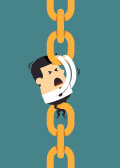
Broken links can do significant damage to the user experience on your site, and thus also damaging your SEO. First, Google knows that users hate clicking on broken links and because Google is invested in ensuring users have a great experience on the web, sites with a known poor user experience get penalized in the rankings. However, deeper than this, links pass PageRank and therefore broken links are a waste of link juice. For large, dynamic sites like directories or social sites, broken links are one of the largest and most consistent problems they face.
Step 1: Find the broken links. There are numerous tools available for finding broken links on your site. Here are a few web based tools:
- https://www.google.com/webmasters/tools/crawl-errors
- http://www.brokenlinkcheck.com/
- http://validator.w3.org/checklink
And here are a few downloadable tools (that I personally prefer).
- For Mac: https://itunes.apple.com/us/app/integrity/id513610341?mt=12
- For PC: http://www.powermapper.com/products/sortsite/checks/link-checker.htm
- Screaming Frog SEO spider will identify 404 pages, and those pages should be redirected.
Step 2: Fix the broken links. Internal broken links will likely be pointing to your 404 error page. Any broken links should be 301 redirected to the most appropriate internal page based on the broken link. A good 404 error page should also suggest content that seems relevant to the URL string of the broken link that got the visitor to the 404 page.
While 301 redirects will definitely take care of broken links, it is better to switch the actual links on the pages where they appear to the new URL if that is possible.
Remember To
Check and Fix Broken Links Regularly!
Next In the next lesson we will address the proper way to handle
